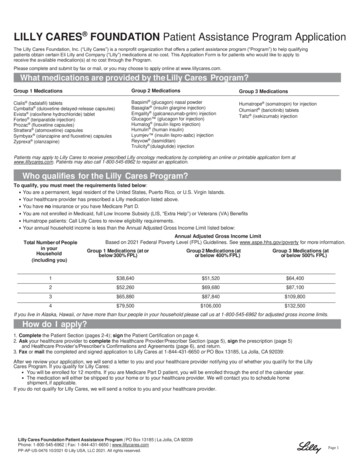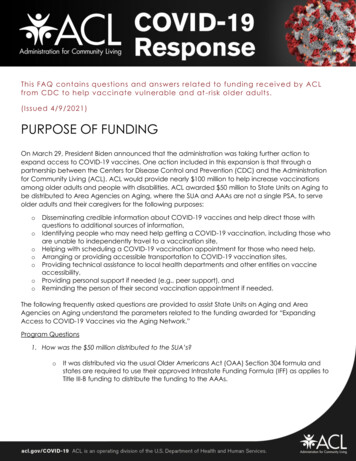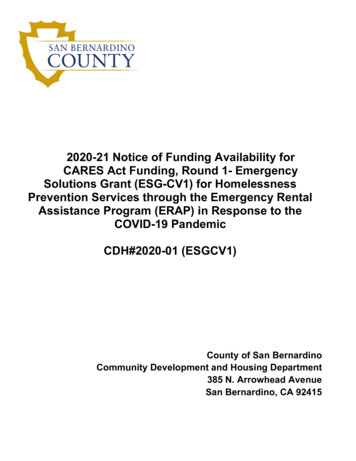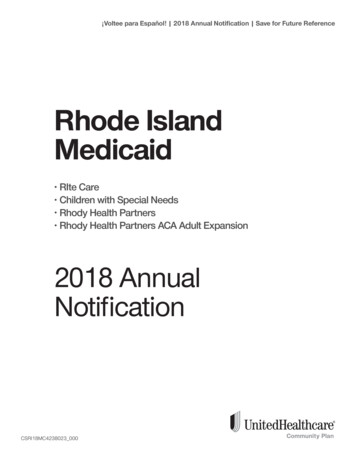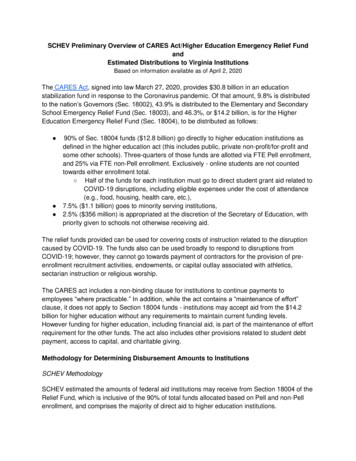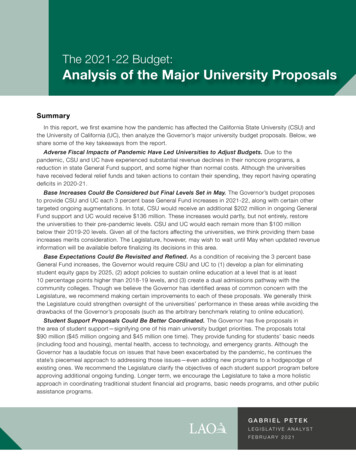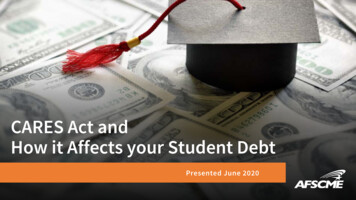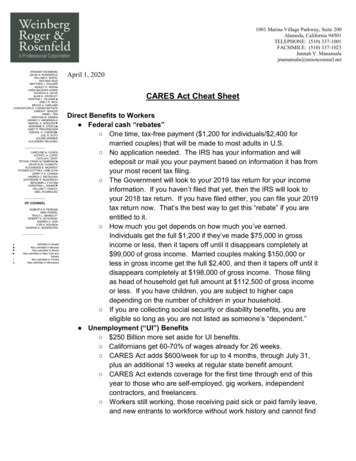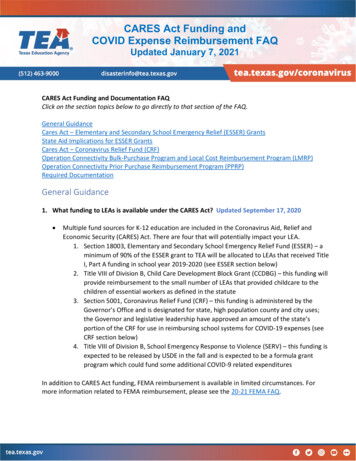
Transcription
CARES Act Funding andCOVID Expense Reimbursement FAQUpdated January 7, 2021CARES Act Funding and Documentation FAQClick on the section topics below to go directly to that section of the FAQ.General GuidanceCares Act – Elementary and Secondary School Emergency Relief (ESSER) GrantsState Aid Implications for ESSER GrantsCares Act – Coronavirus Relief Fund (CRF)Operation Connectivity Bulk-Purchase Program and Local Cost Reimbursement Program (LMRP)Operation Connectivity Prior Purchase Reimbursement Program (PPRP)Required DocumentationGeneral Guidance1. What funding to LEAs is available under the CARES Act? Updated September 17, 2020 Multiple fund sources for K-12 education are included in the Coronavirus Aid, Relief andEconomic Security (CARES) Act. There are four that will potentially impact your LEA.1. Section 18003, Elementary and Secondary School Emergency Relief Fund (ESSER) – aminimum of 90% of the ESSER grant to TEA will be allocated to LEAs that received TitleI, Part A funding in school year 2019-2020 (see ESSER section below)2. Title VIII of Division B, Child Care Development Block Grant (CCDBG) – this funding willprovide reimbursement to the small number of LEAs that provided childcare to thechildren of essential workers as defined in the statute3. Section 5001, Coronavirus Relief Fund (CRF) – this funding is administered by theGovernor’s Office and is designated for state, high population county and city uses;the Governor and legislative leadership have approved an amount of the state’sportion of the CRF for use in reimbursing school systems for COVID-19 expenses (seeCRF section below)4. Title VIII of Division B, School Emergency Response to Violence (SERV) – this funding isexpected to be released by USDE in the fall and is expected to be a formula grantprogram which could fund some additional COVID-9 related expendituresIn addition to CARES Act funding, FEMA reimbursement is available in limited circumstances. Formore information related to FEMA reimbursement, please see the 20-21 FEMA FAQ.
The National School Lunch program also received additional funding under the CARES Act to supportadditional meals provided through their normal formula program.2. For a charter school that receives the PPP loan, what account code will be used for a charter torecord the loan proceeds/revenue? Assuming it is ultimately forgiven. Posted July 28, 2020Charters should record it like other grants if partial or total forgiveness is expected. As therequirements of the loan are met and is officially forgiven, they would recognize the forgiveness as arevenue and reduce the loan payable. For the portion of the loan that is not met it would remainrecorded as a loan payable and would accrue interest. This would be recorded in fund 420 withfederal revenue object code 5949. It would be reported separately from CARES (ESSER) funding.If the charter receives PPP for COVID-19 related expenses, those expenses may not reimbursableunder the CRF reimbursement program administered by TDEM.3. Will CARES Act Funds be allowed to replace lost revenues in the Child Nutrition Budget to offsetthe wages LEAs continued to pay employees while not working during school closures? Also,for wages incurred to provide meals to our community under the Summer Feeding Program.Posted July 28, 2020These activities could be paid under the ESSER grant.4. Is it possible to pay for portables with FEMA funds? Updated September 17, 2020No, not under the Category B costs, which are the only allowable FEMA expenses for LEAs for thepandemic.FEMA reimbursement is available in limited circumstances. For more information related to FEMAreimbursement, please see the 20-21 FEMA FAQ.5. Many LEAs used busses to feed or deliver packets to students, so we have many busses stillrunning. What if busses were used to deliver food and instructional packets? Posted May 28,2020While transportation costs related to using busses to deliver meals or instructional packets may beallowable under the ESSER grant, it is not eligible mileage to report to TEA for reimbursementthrough the state transportation allotment. Mileage driven for COVID-19 related services can bereported on the Transportation Operations Report but must not be included in the TransportationRoute Services Report of the FSP Subsystem.2
Cares Act – Elementary and Secondary School Emergency Relief (ESSER)Grants1. Where can I find the ESSER grant entitlement amounts that my LEA will receive? Posted May21, 2020The entitlements will be posted by May 22 to the grant entitlements web page under the federalfunds section of the TEA Grants web page and in the Waivers, Finance and Grants section of theCoronavirus web page.2. When will the ESSER funding be available? Posted May 21, 2020The grant application will release in June. Training on the application will be made available aroundthe opening date of the application.The Grants Administration Division will issue a preliminary NOGA by email within ten (10) businessdays of receipt of the application to TEA. This preliminary NOGA will 1) release 20% of the funding,2) be in the format of an email to the superintendent as listed in AskTED, or the authorized official asidentified on page one of the applications, along with the primary and secondary contacts listed onpage one of the application, and 3) not look like a standard NOGA.The LEA will later be able to view the preliminary NOGA in the ER system and print it for theirrecords. In the meantime, the LEA should maintain the email preliminary NOGA as documentationthat the 20% of grant funds are available. The LEA will receive the official, full NOGA and access to100% of the grant award after the application is negotiated and awarded.3. How are the ESSER funding amounts calculated? Posted May 21, 2020TEA has calculated the entitlements following the statutory formula and guidance provided by USDE.The formula states that an LEA will receive the same proportionate share of the total ESSER formulagrant as it received in proportion to the state’s Title I, Part A grant in 2019-2020. You can find LEAspecific amount information on the grant entitlements web page by May 22, 2020.4. What type of reporting will be required? Updated July 23, 2020In addition to standard expenditure reporting through the ER system, USDE had previously statedthat quarterly reporting would be required for the ESSER grant under the CARES Act. However, thequarterly reports are no longer required. USDE has notified TEA that they will instead use existingreporting mechanisms that TEA already submits to meet the quarterly reporting requirement underthe CARES Act.3
USDE will require an annual report from the state. TEA will require LEAs to submit required dataelements in a time and manner to be determined after USDE releases the data reporting elementsand instructions.Remember, the questions in the application for funding regarding the uses of funds and the plannedquarter of the expenditure are not related to the previous quarterly reporting requirement and muststill be completed in order to receive a NOGA.5. Will COVID-19 expenses back to the start of the school closures be allowed as pre-award costsunder the CARES Act stimulus funding? Updated July 23, 2020USDE is allowing pre-award costs for the ESSER funding back to March 13, 2020. Expenses must beallowable under the ESSER statute (see question 18 below) and have occurred on March 13, 2020, orafter.All activities charged to the ESSER grant must be reasonable and necessary to meet the overallpurpose of the program, which is “to prevent, prepare for, and respond to” the COVID-19 pandemic.6. Once we know the expenditures can be legally charged to the ESSER grant, how will we codethe expenditures in our accounting system? Posted April 14, 2020For accounting purposes, you will code the expenses using the 15-digit beginning with a three-digitfund code to comply with FASRG and ending with a local option code to indicate the expense wasCOVID-19 related. The expenditures for the LEA ESSER grant will be recorded under fund code 266with the appropriate program intent code (PIC) related to the allowable activities for which funds willbe expended. When the use of a PIC is not appropriate or mandatory to a specific program,expenditures can be coded to PIC 99.For example, a transaction charged to the stimulus grant for payroll costs pursuant to IDEA-B will becoded as per following: 266-11-6119-00-101-0-23-V-00, where “V” is a local option code for thecoronavirus.7. Is there a supplement, not supplant provision in the ESSER funding? Posted May 21, 2020No.8. Can TEA provide some guidance on ESSER funding for the LEAs and paying their employees andcontractors? Posted May 21, 2020LEAs that receive ESSER funds are required, to the greatest extent practicable, to continue to payemployees and contractors during the period of any disruptions or closures related to Coronavirus.(See related guidance in the Federal Funding and Grants FAQ on the TEA Coronavirus web site.)4
9. Will the ESSER funding have the same life span as current Title I, Part A dollars? Posted May21, 2020The ESSER grant is a separate federal grant program, and is not Title I, Part A funds. The grant periodfor the ESSER grant is May 15, 2020, through June 30, 2021, with 12 additional months carryoverunder the Tydings amendment. This means the LEA may begin to expend funds on March 13, 2020,(pre-award begin date) through September 30, 2022.10. Can my district recognize the reduction in FSP revenue in 2019-2020 and then wait to recognizethe ESSER Grant revenue in 2020-2021 in our annual financial audits in order to help withCOVID costs incurred for instruction in 2020-21? Posted June 4, 2020Yes. The ESSER grant funds may be expended March 13, 2020, through September 30, 2021, with 12additional months carryover under the Tydings Amendment through September 30, 2022. The FSPreduction that the ESSER funds will offset will be taken in the 2019-2020 fiscal year. Please note thatthis approach could cause the LEA’s expenses to exceed its revenue resulting in the LEA ending theyear with a deficit. In addition, the LEA should ensure the final budget reflects the reduced FSPrevenue and record its impact on FSP settle up. Also, this may cause the LEA to fail the FinancialIntegrity Rating System of Texas (FIRST) indicator 9.11. Will there be a separate application, or will the monies be added to the ESSA application?Posted May 21, 2020Due to the ESSER grant funding having a different funding period, and to be able to develop theapplication and award the grants more efficiently, ESSER will require a separate grant application(see timeline described in question 3 above) and will not be a part of the ESSA ConsolidatedApplication for Funding.12. Are the ESSER funds available only for LEAs to receive reimbursement for additional expensesduring this pandemic or is there a guaranteed amount each LEA will receive based on their TitleI qualifications? Posted May 21, 2020The ESSER grant is distributed as a formula grant based on the proportionate share of the state’s TitleI, Part A allocation received by each LEA in 2019-2020. This is a statutory formula program, and eacheligible LEA will receive an entitlement amount for which they may apply by submitting the grantapplication. The ESSER funds may be used for any of the allowable activities listed in question 18below.13. Will the ESSER funding come to LEAs through TEA’s normal grant processes? Posted May 21,2020Yes, the ESSER funds will be a standard TEA grant application with payments being requestedthrough the eGrants Expenditure Reporting (ER) system.5
There will be additional reporting required for the ESSER funds.14. What fiscal year should these funds be accounted for? Posted May 21, 2020The funds will be accounted for in the fiscal year in which they are expended.15. Will my school board need to approve a budget amendment in order to spend these funds?Posted May 21, 2020The funds will be awarded through a new grant application, with amendments as needed throughoutthe life of the grant. The LEA must follow its normal policy for providing public notice of the grantapplication, which is normally through it being an agenda item for the school board to review formost LEAs.16. By when do these funds need to be expended? Posted May 21, 2020The grant period will end September 30, 2022. All eligible expenditures must occur within the grantperiod.17. Are all LEAs eligible for ESSER grants? Posted May 21, 2020No. Only LEAs who were eligible, applied for, and received Title I, Part A funds in 2019-2020 areeligible for ESSER grants.18. Will the ESSER funding allow the LEAs to pay for the direct costs incurred for planning andmitigation of the coronavirus pandemic such as, but not limited to, additional technology, hotspots for internet service, costs of distance learning, and cleaning of buildings to include stafftime and supplies? Posted May 21, 2020Yes. Ninety percent (90%) of the ESSER funding is a formula grant program to LEAs based on astatutory formula. All these types of costs appear to be allowable costs under the ESSER grantprogram.The following activities are allowable under the grant as specified in the statute.1. LEA discretion for any purpose under:1. Elementary and Secondary Education Act (ESEA)2. Individuals with Disabilities Education Act (IDEA)3. Adult Education and Family Literacy Act (AEFLA)4. Perkins Career and Technical Education Act5. McKinney-Vento Homeless Education Act6
2. Activities related to coordination of preparedness and response to improve coordinatedresponses among LEAs with state and local health departments and other relevant agenciesto prevent, prepare for, and respond to coronavirus3. Provide principals and others school leaders with the resources necessary to address theneeds of their individual schools4. Address the unique needs of low-income children or students, children with disabilities,English learners, racial and ethnic minorities, students experiencing homelessness, and fosterstudents including how outreach and service delivery will meet the needs of each population5. Developing and implementing procedures and systems to improve the preparedness andresponse efforts of LEAs6. Training and professional development of LEA staff on sanitation and minimizing the spreadof infectious diseases.7. Purchasing supplies to sanitize and clean facilities operated by the LEA8. Planning for and coordinating during long term closures, including for how to provide mealsto eligible students, how to provide technology for online learning to all students, how toprovide guidance for carrying out requirements under IDEA, and how to ensure othereducational services can continue to be provided consistent with all Federal, State, and localrequirements9. Purchasing educational technology (including hardware, software, and connectivity) forstudents who are served by the local educational agency that aids in regular and substantiveeducational interaction between students and their classroom instructors, including lowincome students and students with disabilities, which may include assistive technology oradaptive equipment10. Providing mental health services and supports11. Planning and implementing activities related to summer learning and supplementalafterschool programs, including providing classroom instruction or online learning during thesummer months and addressing the needs of low-income students, students with disabilities,English learners, migrant students, students experiencing homelessness, and children infoster care.12. Other activities that are necessary to maintain the operation of and continuity of services inLEAs and continuing to employ existing staff.19. Can the ESSER funds be used for construction? Updated July 23, 2020On July 22, 2020, USDE notified TEA of the following guidance on construction as a potentiallyallowable cost for LEAs. Construction as part of PNP equitable services is not allowed.Because ESSER funds may be used for “any activity authorized by the ESEA,” and construction is anallowable activity under the ESEA’s Impact Aid program, an LEA may use ESSER funds forconstruction, subject to prior written approval by TEA. Specifically, in ESEA, Section 7013(3) theImpact Aid definition of “construction” includes (A) the preparation of drawings and specifications forschool facilities; (B) erecting, building, acquiring, altering, remodeling, repairing, or extending school7
facilities; (C) inspecting and supervising the construction of school facilities; and (D) debt service forsuch activities.As is the case with all activities charged to the ESSER grant, construction costs must be reasonableand necessary to meet the overall purpose of the program, which is “to prevent, prepare for, andrespond to” the COVID-19 pandemic. Therefore, any construction activities, including renovations orremodeling, that would be necessary for an LEA to prevent, prepare for, and respond to COVID-19would be allowable. This might include renovations that would permit an LEA to clean effectively(e.g., replacing old carpet with tile that could be cleaned more easily) or create a learningenvironment that could better sustain social distancing (e.g., bringing an unused wing of a school intocompliance with fire and safety codes in order to reopen it to create more space for students tomaintain appropriate social distancing).Approved construction projects must comply with applicable Uniform Grant Guidance requirements,as well as the Department’s EDGAR regulations regarding construction at 34 CFR § 76.600. As is thecase with all construction contracts using laborers and mechanics financed by federal educationfunds, an LEA that uses ESSER funds for construction contracts over 2,000 must meet all DavisBacon prevailing wage requirements and include language in the construction contracts that allcontractors or subcontractors must pay wages that are not less than those established for the localityof the project (prevailing wage rates).20. Pre-award costs are allowed back to March 13, 2020. We anticipate payroll being paid throughthe ESSER grant. Each employee has multiple payroll accounts including salary, TRS, Medicare,Federal Withholding, etc. To avoid having to journal voucher the many payroll codes for eachemployee, could we recode salary now for future payrolls in anticipation of funding? PostedMay 21, 2020Yes, under certain circumstances. Once the ESSER grant application is available in June, you maycharge allowable costs to fund code 266.USDE is allowing the ESSER funding to offer pre-award back to March 13, 2020. You will be able tocharge allowable costs to the ESSER funding (fund code 266 when it becomes available) starting onthat date for these added COVID-19 costs incurred by the LEA. If you choose to charge salaries,ensure they are reasonable, necessary, and allocable charges to the new fund source 266.21. Will the expense of setting up and using technology to remotely register and enroll students orrecruit and hire staff be allowable costs under the ESSER grant? Posted May 21, 2020Yes, those types of costs are allowable.22. My district transferred general funds in order to fund the child nutrition expenses in light ofreduced food service revenue. Can we use these funds to replenish the general fund? PostedMay 21, 20208
It depends. The LEA must first receive all allowable reimbursement from the Child Nutrition Programthrough the Texas Department of Agriculture. Additional costs not reimbursed by TDA may beallowable expenses under the ESSER grant.23. Since there is no supplement, not supplant rule, can the LEA just select an appropriate amountof costs previously paid with the general fund and transfer them to ESSER, freeing uppreviously spent general fund? Posted May 21, 2020Yes. That is one possibility to use the funding as long as the expenses are allowable under the ESSERstatute. (See question 17 above for the allowable statutory uses.)Another option is to look at uses in the coming months that would have otherwise been paid withother fund sources and are allowable costs under ESSER and charge those expenses to the ESSERgrant (fund code 266). Both of these options free up the LEA’s other fund sources and utilize theESSER funds in a way that is allowable with the federal statute, saving the LEA’s general fund.24. Will my LEA be required to document time and effort reporting for these funds? UpdatedJuly 23, 2020An LEA must maintain time distribution records (sometimes called “time and effort” reporting) only ifan individual employee is splitting his or her time between activities that may be funded under ESSERand activities that are not allowable under ESSER. However, there will be very few situations when anemployee of an LEA would perform multiple activities where some are not allowable under ESSER,and thus would be required to maintain time distribution records, given that an LEA is authorized touse funds on “activities that are necessary to maintain the operation of and continuity of services in[an LEA] and continuing to employ existing staff of the [LEA]” in order to “prevent, prepare for, andrespond to” the COVID-19 pandemic.This means there are very limited instances when time and effort records are needed for salary costs.USDE stated to TEA staff on July 22, 2020, that almost any LEA staff position would be allowableunder the ESSER grant.25. What guidance is available on private school services authorized under the CARES Act stimulusfunding? Posted May 21, 2020The LEA is required to offer equitable services to all private nonprofit schools within its boundarieswith funds received under the ESSER grant, and potentially other grant funds that may becomeavailable in the future. The LEA will provide consultation with PNP officials and provide equitableservices (not funding) to those PNP schools who choose to participate. The PNP may identifyallowable services to meet their needs, and those PNP services are not required to be the same asthe services the LEA provides to its campuses, students, or staff. Detailed equitable services guidanceis being developed and will be released when it is available.9
26. We need to purchase masks for the graduation ceremony for graduates and staff. Would it bebest to purchase graduation items (masks etc.) with Title IV or a local budget and thenreimburse the funding source when ESSER funds are available? Posted May 28, 2020It could be an allowable expense under either scenario; however, it will only be allowable if the LEA isfollowing the state’s guidance/rules for graduation ceremonies.27. Are there any grants available to provide Internet service for our students? We have somedevices but paying for the service is more than our rural school can afford. Posted May 28,2020Internet service for students would be an allowable expense for the ESSER grant. Many internetservice providers also provide free or discounted rates for low-income students. See this documentfor more information.28. Will ESSERF grant will have a compliance report? Updated July 23, 2020Yes. USDE will require an annual report from the state. TEA will require LEAs to submit required dataelements in a time and manner to be determined after USDE releases the data reporting elementsand instructions.In addition, the quarterly reports that were previously being required by USDE are no longerrequired. USDE has notified TEA that they will instead use existing reporting mechanisms that TEAalready submits to meet the quarterly reporting requirement under the CARES Act.29. Are CARES Act funds for current participating PNP's or any PNP in the school boundary zones?Posted May 28, 2020Any private nonprofit school located within the school district’s boundaries may request andparticipate in the equitable services provision under the ESSER grant.30. Is the state’s estimated 5% of funding for PNP equitable services included in the districtallocations posted on the website or is that a net of the private school allocations? Posted May28, 2020The 5% is an estimate of the potential statewide equitable services amounts based on the PNPenrollment data available to TEA. The district allocations posted include the amount to be providedto private nonprofit schools as equitable services.PNPs do not receive allocations, rather they receive equitable services from the school district withinwhose boundaries the PNP is physically located. Each district must provide outreach and consultationwith private school officials to determine which private nonprofit school will participate in equitable10
services so that the calculation of the equitable services amount can be done at the district level. Formore information, see the CARES Equitable Services Guidance document.In the event that the district receives valid and appropriate requests for equitable services thatexceed 5% of the LEA’s ESSER allocation, contact the Department of Grant Compliance andAdministration at GrantSupport@tea.texas.gov. TEA has reserved a portion of state-level funds toaccount for any overage in equitable services incurred by a district.31. If there are no PNP in our District, will we be able to spend 100% of the ESSER funds listed onthe entitlements webpage? Posted June 4, 2020Yes.32. Are charter schools subject to PNP equitable services requirements? Also, how would thatimpact the ADA adjustment as it relates to the ESSER Grant funds? Posted June 4, 2020No, charter schools are not subject to PNP equitable services requirements since they do not havephysical boundaries. Furthermore, because school districts have PNP equitable services requirements,and charters do not, the subtraction of 5% of the ESSER grant that is withheld prior to the calculation ofthe ADA hold harmless in question #1 of the general state funding FAQ is not applicable to charterschools. This means that the ADA adjustment will reflect the full amount of the ESSER grant for charterschools.33. Can an LEA pay for normal operating costs such as, but not limited to, utilities with ESSER grantfunds? Updated July 23, 2020Yes, if the LEA can document it as an allowable activity under the statutory allowable activities,primarily item #12.USDE notified TEA staff on July 22, 2020, that since the LEA did not have ESSER funding when theprocurement of such items was made, the LEA must only have documentation that it followed stateand local procurement rules at the time of the procurement. The operating costs must be treatedconsistently as either direct costs or indirect costs and all activities charged to the ESSER grant mustbe reasonable and necessary to meet the overall purpose of the program, which is “to prevent,prepare for, and respond to” the COVID-19 pandemic.Specifically, for costs paid with ESSER between March 13, 2020, and the date the ESSER grant awardis issued (the date of the preliminary NOGA releasing 20% of the funds) the LEA is not required to beable to document any federal procurement process.Once the LEA receives the preliminary NOGA, the LEA must be able to document that all expensesand procurements followed the required federal procurement rules. This means that most likely the11
LEA may only charge utilities and other operating costs to the ESSER grant between March 13, 2020,and the date the preliminary NOGA is received (pre-award costs).However, at TEA’s request USDE is reviewing this response and may issue further guidance. Thisresponse will be revised as appropriate at that time.34. Our LEA brought in payroll staff during school closure due to COVID 19, these employees werepaid premium pay. May ESSER funds be used to reimburse 100% of their pay? Posted June 18,2020Yes, if the LEA 1) had an existing premium pay policy in place, or 2) approved such a policy prior topaying the premium pay, and 3) followed its approved policy.35. Is there an impact to IDEA-B LEA MOE compliance for an LEA that uses ESSER funds (Fund Code266) versus General Funds (Fund Codes 199/420/437) on special education (PIC 23/33)expenses or to ESSA LEA MOE compliance? Posted July 16, 2020It depends. For example, the IDEA-B LEA MOE calculation includes only Fund Codes 199/420/437 so ifthe amount charged to those Fund Codes goes down as a result of some expenditures being chargedto Fund Code 266 then there would be an impact. Similarly, the ESSA LEA MOE calculation includesonly Fund Codes associated with Local/State expenditures and excludes Fund Codes associated withfederal expenditures such as Fund Code 266.However, LEAs received additional funds in 2019–2020 due to HB 3, which individual LEAs may haveexpended on special education or other general education instructional uses. As a result, it is verydifficult to determine the precise impact of these changes to an individual LEA for either IDEA-B orESSA LEA MOE. However, we have asked USDE this question and will update the CARES Act FAQdocument when a response is received.36. May an LEA consolidate administrative funds from the ESSER grant into the ESSA ConsolidatedAdministrative Fund and have the flexibility of consolidating its administrative funds? PostedJuly 23, 2020Yes, An LEA may consolidate administrative funds under the ESSER grant to administer the programsincluded in the consolidation and for administrative activities designed to enhance the effective andcoordinated use of funds under programs included in the consolidation.37. May and LEA use ESSER funds to pay for COVID testing or doctor visits when required for astudent to return to on-campus instruction and the student does not have health insurance?Posted October 8, 202012
Per USDE communication to TEA on October 7, 2020, ESSER funds can be used to pay for studenttesting or for doctor visits when the family does not have health insurance. Generally, there is noprohibition on using funds for medical services in the CARES Act. As long as the activity meets thepurposes of the ESSER program
portion of the CRF for use in reimbursing school systems for COVID-19 expenses (see CRF section below) 4. Title VIII of Division B, School Emergency Response to Violence (SERV) - this funding is expected to be released by USDE in the fall and is expected to be a formula grant program which could fund some additional COVID-9 related expenditures
